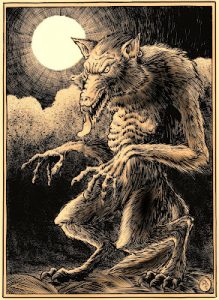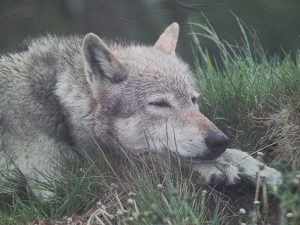
Sabine Baring-Gould claims that ‘English folklore is singularly barren of werewolf stories , the reason being that wolves had been extirpated from England under the Anglo Saxon kings, and therefore ceased to be the object of dread to the people’ (Book of Werewolves, 1867, p. 77). This is what makes the sightings of the Hull werewolf, known as ‘Old Stinker’, in the last few days all the more intriguing. OGOM has been busily reporting on coverage of this contemporary phenomena (see for example ‘Werewolf Sightings in Yorkshire’ and ‘Ancient Werewolf Known as ‘Old Stinker’ Sparks Folk Panic in the UK‘). In literature accounts of werewolfism or lycanthropy can be traced back to the epic of Gilgamesh in 1200 (whereas wolf fables begin with Aesop’s ‘The Boy Who Cried Wolf ‘ in 620- 520 BC). Virgil’s Eclogues are thought to be the first account of voluntary werewolfism (42-39 BC) but lycanthropy is more commonly seen as ‘a curse’ or a sign of bestiality, or at worst of cannibalism. Those who were executed in werewolf trials in the middle ages were believed to have a taste for human flesh. With the advent of psychoanalysis werewolfism came to more commonly represent the ‘beast within’ or everything animal that we have repressed in terms of our human nature. The werewolf is the spectre brother or shadow self of the wolf and the history of werewolfism can easily be juxtaposed with humankind’s treatment of wolves. The much talked about case of Peter Stumpf, who was executed for being a werewolf in 1589, corresponds with the extinction of the wolf in England in the 1500s (although the extinction of wolves across Europe did not occur until 1800s). Wolves held out in Ireland until the 1700s (though they were extinct in Scotland by the late 1600s). These dates are well documented by Garry Marvin and others. In 2015 OGOM reported on attempts to re-wild the wolf in the UK and elsewhere at the Company of Wolves conference. We began to question what would happen if wolves returned to our forests and this was prominent in the many media reports of the conference in The Independent, The Guardian and elsewhere.
In the 1880s British traveller Emily Gerard accounted for the Romanian belief in werewolves by equating it with fear of the wolf, ‘as long as the flesh and blood wolf continues to haunt the Transylvanian forests, so long will his spectre brother survive in the minds of the people’ (The Land Beyond the Forest, 1888). The emergence of the Hull werewolf ‘Old Stinker’ in the last few days has reopened debates about the werewolf’s relationship to the ‘flesh and blood wolf’. At OGOM we often get asked what causes belief in werewolfism (and vampirism) and what is most pertinent and magical about this latest folk panic is that ‘Old Stinker’ is thought to inhabit a landscape which saw some of the last wolves in England. He represents then, not our belief in him as a supernatural shapeshifter, but our collective guilt at the extinction of an entire indigenous species of wolf. Far from dismissing the myth, my instincts are to embrace it and see it as a manifestation of our cultural memory around wolves. Contrary to the assertions of Gerard, the ‘Old Stinker’ story tells us that belief in werewolves lives on beyond the actual lives of the wolves who were thought to inspire them. Rather than being dismissed as a rather fishy tale, ‘Old Stinker’, can inspire the wolf warrior in all of us and allow us to lament the last wolves who ran free in English forests. ‘Old Stinker’ is far from being a curse, in fact he is a gift; he can reawaken the memory of what humans did to wolves, raise awareness of re-wilding debates, and redeem the big bad wolf that filled our childhood nightmares, reminding us that it is often humans, not wolves or the supernatural, that we should be afraid of.


Pingback: Why I believe in the story of ‘Old Stinker’ the Hull Werewolf | Open Graves, Open Minds |
Yes! Now this is how I can embrace the legend of ‘Old Stinker’. (I still can’t be convinced that there is actually an 8ft Wolf-Man wandering about in Hull). It is notable that the various media accounts of the Werewolf of Hull have connected these sightings to the fact that the Yorkshire Wolds as one of the last places where wolves survived in England. Moreover, a couple of commentators have pointed out that wolf bounties remain in place in England even after wolves have become extinct – as the memory of the creature far outlives the threat of the animal itself. This quotation I think sums up a huge amount about how the werewolf can be seen as intermediary between the human and the wolf and lycanthropes function as a symbolic exchange:
‘Neither the historical record of humanity nor of wolves (if wolves could write one) would be complete without something being said about the other species’.
(Steven H. Fritts, Robert O. Stephenson, Robert D. Hayes, and Luigi Boitani, ‘Wolves and Humans’, in L. David Mech and Luigis Boitani (eds), Wolves: Behaviour, Ecology and Conservation (Chicago and London: University of Chicago Press, 2003), pp. 289-316 (p. 289)).
Our imagination will perhaps forever be haunted by the wolf and will continue to exchange its real-world form for that of the werewolf.
Yes, that quote is perfect. This has made me think more clearly about the radio 4 material we are preparing…funny how everything is related!! Old Stinker is not so much of a red herring or just plain fishy in fact he symbolises the whole of the CoW project I think! Looking forward to writing about him in the intro to the CoW book. I just wish more peeps would respond to what we are posting on here. If you are following us on facebook do please share your thoughts on this story here. We would love you to join in the debate on the blog!
has anyone actually ever seen this thing or is just a myth?
Well both….it has grown into something of an urban myth but I have written on the various recorded sightings in my articles below: https://www.academia.edu/33708017/Wolves_in_the_Wolds_Late_Capitalism_the_English_Eerie_and_the_Wyrd_Case_of_Old_Stinker_the_Hull_Werewolf
and here
https://theconversation.com/why-we-should-welcome-the-return-of-old-stinker-the-english-werewolf-67797